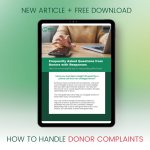Why face-to-face meetings matter more than ever for nonprofits
Do you remember the first Zoom meeting you had with a staff member or a donor? Or maybe the first online webinar you attended or hosted? How we work, how we socialize and how we interact has changed significantly post pandemic. Many have accepted this “new normal” and embraced its benefits… but could there be unintended consequences to our fundraising?
Technology and the internet have provided many options for nonprofits to ask for gifts and raise awareness for these organizations and their cause and mission. But a big concern for many of these organizations in a tech-driven world is managing all the email, social media and mobile outreach channels they use to connect with current donors and attract new supporters.
Organizations that are thriving in these digital channels should not forget one of the most effective tools for nonprofit fundraising: face-to-face meetings.
There is indeed an unspoken power of face-to-face fundraising. Interacting with a donor or a prospective donor in person has advantages that a phone call or a virtual meeting will not accomplish. As First Nonprofit puts it, “meetings in person offer advantages that simply aren’t present with other methods.
6 benefits of face-to-face interactions in fundraising
Here are 6 benefits of face-to-face interactions for nonprofit fundraising that I hope you will find helpful as you schedule your next meeting with that special donor.
- Face-to-face meetings are not just about asking for donations. They’re about building an authentic bond where an organization can share compelling stories, answer questions and establish a genuine relationship. These personal interactions provide a sense of trust and credibility, and build the emotional connection between the cause and the donor.
- Face-to-face interactions offer a personal touch. Body language, eye contact and verbal communications help capture the attention of a potential supporter in a way a virtual meeting cannot.
- Any issues or problems are easier to resolve when you’re physically with the donor. The best way to find a solution to a problem is by interacting with the donor through the most personal means possible.
- A personalized conversation allows a nonprofit to tailor their message to the individual donor’s values and interests. This personalized approach increases the chance a donor will feel heard, seen and known, resulting in a strong emotional connection with the organization’s mission.
- Face-to-face interactions provide opportunities for an organization to address donor skepticism about how their gifts are being utilized. Organizations can use these meetings to outline specific projects and openly showcase the impact of their donations. This transparency builds trustworthiness and strengthens the donor’s confidence in the organization.
- An in-person meeting cultivates a sense of partnership. Donors who have engaged in face-to-face interactions with organizations usually have a deeper connection to the cause and are more likely to be an advocate.
The ability for an organization to establish an authentic connection, engage emotions, tailor messages, promote transparency and build a sense of partnership sets face-to-face interactions aside as a strong and dynamic method for delivering helpful changes.
In a world where we can sometimes feel disconnected, it is these face-to-face meetings that produce the most impact for a relationship – and ultimately, a greater impact on your nonprofit fundraising and the good work that you do.
Stay updated on what’s next for nonprofit fundraising!
Sign up for our newsletter today to get the fuel that will help boost your fundraising for nonprofits to the next level.





